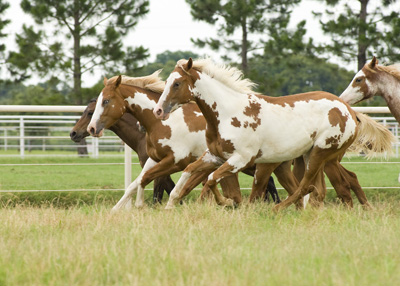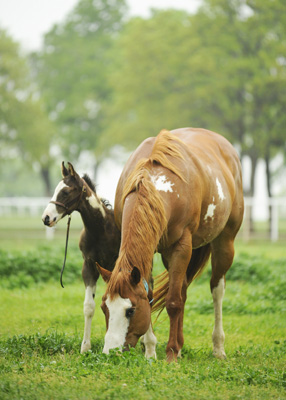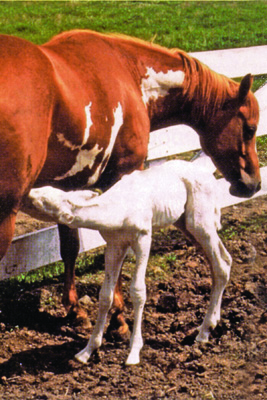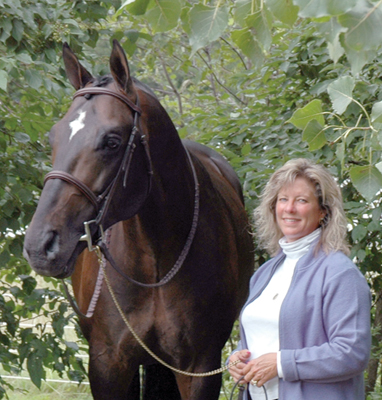 In addition to the five-panel genetic test which consists of Hyperkalemic Periodic Paralysis Disease (HYPP), Hereditary Equine Regional Dermal Asthenia (HERDA), Polysaccharide Storage Myopathy (PSSM1), Glycogen Branching Enzyme Deficiency (GBED) and Malignant Hyperthermia (MH), Paint and Appaloosa horse owners can test for several additional disorders, specific to color breeds.
In addition to the five-panel genetic test which consists of Hyperkalemic Periodic Paralysis Disease (HYPP), Hereditary Equine Regional Dermal Asthenia (HERDA), Polysaccharide Storage Myopathy (PSSM1), Glycogen Branching Enzyme Deficiency (GBED) and Malignant Hyperthermia (MH), Paint and Appaloosa horse owners can test for several additional disorders, specific to color breeds.
In Paints, there is, for instance, a genetic test for Frame Overo (LWO) where foals that are homozygous are born “Lethal White,” a fatal condition. There is also testing for Splashed White color (1,2,3) where homozygous horses of SW2 and SW3 should not be bred because it can be potentially fatal to the foal. Testing can also be done to determine the likelihood of getting a Sabino 1 or a Tobiano foal. In particular, horses that are homozygous for the Tobiano gene will always produce color foals.
In Appaloosas, there is a specific test for the Leopard Print (LP). Horses born homozygous with the LP gene will be affected to varying degrees of Congenital Stationary Night Blindness (CSNB) which can cause abnormalities in the eyes and vision.
Although both the APHA and ApHC are aware that many breeders- stallion and mare owners- are conducting genetic tests on their horses in an effort to minimize certain disorders to be passed on and to maximize the likelihood of reproducing desirable color patterns, neither association is requiring testing for registry.
 “We do not require five-panel testing for breeding horses as of yet,” says APHA Customer Service Representative, Jennifer Crites. “There is a possibility genetic testing will become required but the membership has not brought it up as an issue as of now. It has not been proposed as a rule change.”
“We do not require five-panel testing for breeding horses as of yet,” says APHA Customer Service Representative, Jennifer Crites. “There is a possibility genetic testing will become required but the membership has not brought it up as an issue as of now. It has not been proposed as a rule change.”
Working with the University of California at Davis, the APHA does, however, require all breeding stallions have a DNA profile on file and parentage verification on all foals that are by way of embryo transfer or of shipped and frozen semen.
Similarly, the ApHC also requires parentage verification on these foals as well as a non-characteristic foal who would need to be genetic typed before it was able to be registered.
“The board sentiment has been that we are not requiring five-panel genetic testing but I think there has been a renewed interest on the topic and will be something that will be brought up at the next board meeting,” says Steve Taylor, CEO of ApHC.
Taylor explains the overall added cost to registration has been a factor which has ruled out mandatory testing. He does however understand that people have increasingly become more interested in it.
 In fact according to Arne de Kloet, Director of Animal Genetics Inc, their company has seen nothing but an increase every year in the amount of color breeders who are testing. “When the economy started to struggle and the horse business was not doing well, we actually saw a big increase in breeders testing their horses,” he says. “Many breeders are using genetic testing as a way to increase their chances of getting what they want in terms of color and color patterns. They are also decreasing their chances of having a genetic mutation that they do not want their foal to have.”
In fact according to Arne de Kloet, Director of Animal Genetics Inc, their company has seen nothing but an increase every year in the amount of color breeders who are testing. “When the economy started to struggle and the horse business was not doing well, we actually saw a big increase in breeders testing their horses,” he says. “Many breeders are using genetic testing as a way to increase their chances of getting what they want in terms of color and color patterns. They are also decreasing their chances of having a genetic mutation that they do not want their foal to have.”
He also stresses the importance of breeders studying all the genetic disorders that their horse may be able to pass on as well as fully understanding the likelihood of producing certain colors.
“There are many benefits for color breeds to use genetic testing on which to base their decisions,” he says. “We do a lot of testing for color genetics. One of the first tests we offered were for the Lethal White gene.”
In addition, de Kloet has seen many tests conducted by breeders to find out the likelihood of passing a certain color on. Animal Genetics offers a “color coat calculator” that is the most viewed and used feature on its website.”Color testing allows us to be more precise with breeding,” he says. ” Breeders can be more careful and it has helped them produce the foal they want.”
For highly successful, APHA breeder John Yarnelle, of Fort Wayne, Indiana genetic testing has been an asset to his program.
“A few years ago we started to get a lot of questions from our customers about our stallions being genetic tested,” he says. “There started to be a lot of breeders concerned about crossing horses who may both have a genetic mutation. So, we just decided to test all of our stallions and post their results right on our website.”

A Lethal White foal
Yarnelle says he felt it was his responsibility as a breeder to make the status of his stallions known to mare owners so that mistakes are minimized. For example, he explains that if a mare has a lethal white foal beside the heartbreak there is a huge expense involved.
“A lot of times you will actually loose two years breeding if a mare has a lethal white because not only is that foal lost but the mares often do not get back in foal that year,” he says. “Even though the association doesn’t require it, we started testing a lot of our babies because we do get a lot of buyers who want to know.”
One of Yarnelle’s young stallions is appropriately named Guaranteed because he is a homozygous Tobiano. He has seen an increase in mare owners breeding to him because they are guaranteed a color baby.
“I think having a homozygous Tobiano makes a horse more valuable. In Guaranteed’s case we have mare owners who breed to him just because they know they will get a color baby,” he says. “Any Quarter Horse mare in the country can breed to him and they will get a Paint with color. There is a lot of time and money invested in breeding for mare owners to wait a whole year only to end up with a solid.”
Longtime breeder Robin DeGraff of Midway, Kentucky who has stood countless World Champion stallions through the years concurs. Two of the stallions in her roster have a homozygous color gene. Invite the Artist is a homozygous Tobiano and DGS Indygo is homozygous for the black gene, which ensures his foals will always be of black based color. She has seen an increase in breeding to these stallions as a result.
“We have been doing genetic testing for at least the last seven or eight years,” she says. “We want to make informed decisions and educate mare owners about testing. Breeders are then able to get the genetics they want without getting an affected foal.”

Robin DeGraff
Testing all of her stallions was purely mare owner driven because there were so many asking about the status of the stallions. DeGraff says she believes the tests available are a very inexpensive way to eliminate problems.
“We make all our stallion’s results available on the website because I believe it is a positive to present even a negative test result to mare owners,” she says. “We want to avoid passing negative results on to foals because the results can be just heartbreaking.”
Although she admits especially with double registered foals there is a lot of expense involved in registering them with all the incentive programs her babies are eligible for, it is responsible to know the genetic status of your horse.
“Before we were just guessing but now we can make better decisions,” she says. “I think with the rise in activity of the social media and the Internet, there is increasingly more information available and it has helped raise awareness.”
Multiple World Champion trainer, Lisa Ligon of Pilot Point, Texas says she believes genetic testing can be a real asset for breeders. But she has not encountered a whole lot of ApHC breeders taking their own initiative to conduct tests. “I seldom run across Appaloosa breeders who have five-panel tests done on their mares,” she says. “Since they don’t have to test, I don’t think people are going out of their way to test on their own.” She says she believes the added expense of testing is a reason many have not but she does think testing can be a big expense saver in the long run. “I think it’s a benefit to people who do the tests,” she says. “It’s definitely better to know.”
The Barnes family, longtime ApHC breeders from Galatia, Illinois, have bred well over 100 World and National Champions through 30 years in the business. To them, genetic testing is important and so all of their mares are all five-panel tested.
“I’m not sure if the ApHC will require five-panel testing in the near future but I believe they should,” says Tim Barnes.
Testing for the LP factor however is not essential to the Barnes family as Appaloosa breeders because they often breed their color mares to solid AQHA stallions. For example, their solid bay AQHA broodmare Dee Dee Detail has produced three foals in a row all by different colored ApHC stallions who have had a colored, blanketed pattern. Likewise, they bred their leopard colored broodmare, Its Misty N Paradise to AQHA stallion RL Best of Sudden and their 2013 foal was a leopard colored colt.
“We are more concerned about the quality of mind, conformation and movement in breeding,” he says. “Our goal is to improve our mares production in the area they need it to be at the level of today’s modern pleasure horse and to improve the evolution of the stock show horse. Yes, we love to produce colored Appaloosa foals but quality is more important to us. Color is just the cherry on top!”
COLOR TEST GLOSSARY
A Guide to Patterns and Depigmentation Tests Available
Appaloosa Coat Pattern – Leopard Print – (LP)
Homozygous LP horses carry varying degrees of Congenital Stationary Night Blindness (CSNB)
Frame Overo (LWO)
Homozygous are Lethal White foals who die within 72 hours but are often euthanized due to intestinal abnormalities caused by underdeveloped nerves of the foal’s digestive system
Splashed White Overo (SW1, SW2, SW3) SW2 and SW3 Homozygous can be potential lethal so carriers of either gene should not be bred to each other.
Tobiano – Dominant where TT
Homozygous Tobiano horses always produce color
Grey – Dominant where GG
Homozygous Grey horses will always produce Grey coloring
Dominant White – (W3, W5 or W10) Dominant W10 applies to Quarter Horses
Sabino – 1 Homozygous horses will always pass one copy of Sabino on to their foals and are almost pure white in appearance. Unlike LWO, there are no negative side effects surrounding this mutation.
COLOR COAT TESTS
Determine the color of your foal
Red/Black Factor
Agouti (Bay/Black)
Cream Dilution
Dun Dilution
Silver Dilution
Champagne Dilution
Pearl Dilution
Roan
For additional information on All Tests Available and Pricing visit:
Check out Animal Genetics Color Coat Calculator at: www.horsetesting.com/Equine/CCalculator1.asp



You must be logged in to post a comment Login